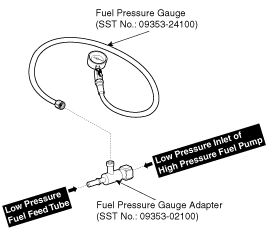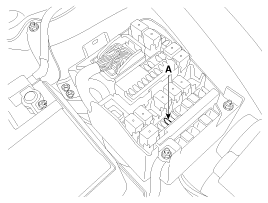Kia Carens: Fuel Delivery System / Repair procedures
Kia Carens RP (2013-2018) Service Manual / Engine Control / Fuel System / Fuel Delivery System / Repair procedures
| Fuel Pressure Test (Low pressure system) |
| 1. |
Release the residual pressure in fuel line. (Refer to Fuel Delivery
System - “Release Residual Pressure in Fuel Line”)
|
| 2. |
Install the Special Service Tool (SST).
|
| 3. |
Inspect fuel leakage on connections among the low fuel feed tube, the
low pressure inlet of high pressure fuel pump, and the SST components
with IG ON.
|
| 4. |
Measure Fuel Pressure.
|
| 5. |
Release the residual pressure in fuel line. (Refer to Fuel Delivery
System - “Release Residual Pressure in Fuel Line”)
|
| 6. |
Test End
|
| Release Residual Pressure in Fuel Line |
Whenever the high pressure fuel pump, fuel pipe, delivery pipe, or injector
is removed immediately after shutting off the engine, an injury may
be caused by the release of highly pressurized fuel. Release the residual
pressure in the high pressure fuel line by referring to the "Residual
fuel pressure release procedure" below before removing any high pressure
fuel system components.
|
Wear safety glasses and fuel resistant gloves.
|
| 1. |
Turn the ignition off and disconnect the battery negative cable.
|
| 2. |
Remove the fuel pump fuse (A).
|
| 3. |
Disconnect the electrical connector from the high pressure fuel pump.
|
| 4. |
Reconnect the battery negative cable.
|
| 5. |
Run the engine for about 20 seconds to lower the pressure in both the
high or low pressurelines. The engine may shut off within the 20 second
period. If not, turn the engine off.
|
| 6. |
Proceed with the service or repair. Use rags to cover opening and catch
spills when opening up the high pressure system.
|
| 7. |
Reinstall / re-connect all components in reverse order of removal. Start
engine and confirm proper operation, and make sure there are no fuel
leaks.
|
| 8. |
After completing, clear DTC(s) using GDS scan tool (the procedure described
above will cause DTC to set).
|
 Components and components location
Components and components location
Components Location
[Fuel tank assembly]
1. Fuel tank
2. Fuel pump
3. Fuel filter
4. Fuel pressure regulator
5. Canister
6. Fuel tank band ...
 Fuel Tank Repair procedures
Fuel Tank Repair procedures
Removal
1.
Release the residual pressure in fuel line. (Refer to Delivery System
- “Release Residual Pressure in Fuel Line”)
2.
...
Other information:
Kia Carens RP (2013-2018) Owners Manual: Using the Tire Mobility Kit (TMK)
1. Detach the speed restriction label (0) from the sealant bottle (1), and place it in a highly visible place inside the vehicle such as on the steering wheel to remind the driver not to drive too fast. 2. Shake the sealant bottle. 3. Screw connection hose (9) onto the connector of the sealant b ...
Kia Carens RP (2013-2018) Service Manual: Repair procedures
On-vehicle Inspection Inspect ignition coil assembly and Perform spark test 1. Check for DTCs. • If a D ...




